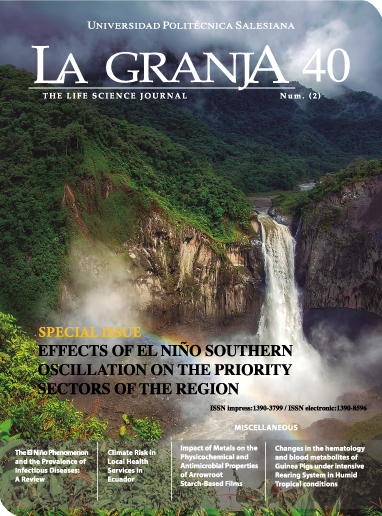Evaluation of urban pollution by noise emissions registered with a sound level meter and sensor nodes
Main Article Content
Abstract
Article Details

This work is licensed under a Creative Commons Attribution-NonCommercial-ShareAlike 4.0 International License.
Universidad Politécnica Salesiana of Ecuador preserves the copyrights of the published works and will favor the reuse of the works. The works are published in the electronic edition of the journal under a Creative Commons Attribution/Noncommercial-No Derivative Works 3.0 Ecuador license: works can be copied, used, disseminated, transmitted and publicly displayed.
The undersigned author partially transfers the copyrights of this work to Universidad Politécnica Salesiana of Ecuador for the printed edition.
References
Aagesen, H. (2002). «Índices basados en Leq». En: Jornadas internacionales sobre contaminación acústica.
Akyildiz, I. y M. Vuran (2010). Wireless Sensor Networks.Vol. 4. John Wiley y Sons.
Alfie, M. y O. Salinas (2017). «Noise in the city. Acustic pollution and the walkable city». En: Estudios demográficos y urbanos 32.1, 65-96. Online: https://bit.ly/3RhuhYY.
Armijos-Arcos, F. (2018). «Predicción de ruido por tráfico vehicular y elaboración del mapa de ruido utilizando el modelo HARMONOISE del Centro Histórico de Cuenca». Tesis de maestría. Universidad Politécnica Salesiana.
Asamblea Constituyente (2008). Constitución de la República del Ecuador. Registro oficial 449. Inf. téc. Asamblea Constituyente.
Bañuelos Castañeda, M. (2005). «Análisis de los niveles de ruido ambiental por tráfico vehicular en puntos críticos de la Zona Metropolitana de Guadalajara y actualización del mapa de ruido». Tesis de maestría. Universidad de Guadalajara.
Basner, M. y col. (2014). «Auditory and non-auditory effects of noise on health». En: The lancet 383.9925, 1325-1332. Online: https://bit.ly/3dALjmQ.
Berlung, B., T. Lindvall y D. Schwela (1999). Guías para el ruido urbano. Inf. téc. OMS.
Bravo Moncayo, L. (2019). Investigadores de la UDLA publican el primer mapa de ruido de Quito.
Burneo, A. (2007a). «Contaminación Ambiental por ruido y estrés en el Ecuador». En: Pontificia Universidad Católica del Ecuador. Cap. El ruido, un criminal sigiloso, págs. 30-38.
Burneo, A.(2007b). «Contaminación Ambiental por ruido y estrés en el Ecuador». En: Pontificia Universidad Católica del Ecuador. Cap. Ruido y contaminación ambiental en Quito.
Cuenca, M. Quiñones y col. (2017). «Sistema De Monitoreo de Variables Medioambientales Usando Una Red de Sensores Inalámbricos y Plataformas De Internet De Las Cosas». En: Enfoque UTE 8.1. Online: https://bit.ly/4cEjDXe, 329–343.
Daiber, A. y col. (2019). «Environmental noise induces the release of stress hormones and inflammatory signaling molecules leading to oxidative stress and vascular dysfunction-Signatures of the internal exposome». En: Biofactors 45.4, 495-506. Online: https://bit.ly/3r1s3Sv.
Fiedler, P. y P. Zannin (2015). «Evaluation of noise pollution in urban traffic hubs-Noise maps and measurements». En: Environmental Impact Assessment Review 51, 1-9. Online: https://bit.ly/3RbdmXE.
García, B. y F. Garrido (2003). La contaminación acústica en nuestras ciudades. Fundación La Caixa.
Gómez, D. y T. Vallarino (2010). Evaluación de impacto ambiental. M. Prensa.
Grass, Y. y col. (2017). «Noise in the stomatological working environment». En: MediSan 21.05, 527-533. Online: https://bit.ly/3r2Yikp.
IDYC (2016). Análisis de la situación actual de ruido. Inf. téc. Guayaquil - Ecuador: IDYC.
INEC (2010). Censo de población y vivienda.
Laforga, P. (2000). «Conceptos físicos de las ondas sonoras». En: Física y Sociedad 11. Online: https://bit.ly/3C5VdGz.
Lin, Chih-Kuang y col. (2011). «A Distributed and Scalable Time Slot Allocation Protocol for Wireless Sensor Networks». En: IEEE Transactions on Mobile Computing 10.4. Online: https://bit.ly/3zsGkPz, págs. 505-518.
Long, M. (2006). Architectural acoustics. Elsevier. Ministerio de Ambiente (2019). Texto unificado de legislación secundaria del Ministerio del Ambiente. Ecuador. Inf. téc. MAE.
Moraga, P. y col. (2017). «Sonidos naturales y entorno urbano. ¿Son compatibles?» En: ACOUSTICS 48o CONGRESO ESPAÑOL DE ACÚSTICA, págs. 446-455.
Nazneen, S., A. Raza y S. Khan (2020). «Assessment of noise pollution and associated subjective health complaints and psychological symptoms: analysis through structure equation model». En: Environmental Science and Pollution Research 27.17, 21570-21580. Online: https://bit.ly/3Se3vle.
Robles, A. y E. Arias (2015). Metodologías de Evaluación: Exposición Ocupacional a Ruido y casos de análisis en agentes ambientales físicos; módulo exposición ocupacional a ruido. Inf. téc. Instituto Regional de Estudios en Sustancias Tóxicas.
Rodríguez, F. (2015). «Ruido ambiental, comunicación y normatividad en la Ciudad de México». En: Razón y Palabra 19.91. Online: https://bit.ly/3dABLbL.
Romo Orozco, J. M. y A. Gómez Sánchez (2013). «Ordenamiento territorial y participación social». En: Instituto Nacional de Ecología. Cap. La percepción social del ruido como contaminante, págs. 271-293.
Salgado, F. y S. Carranco (2017). «Sistema de monitoreo de calidad del aire y ruido ambiental para la determinación de índices de contaminación basado en redes inalámbricas de sensores». Tesis de pregrado. Universidad del Azuay.
UNRN (2010). Laboratorio de Informática Aplicada de la Universidad Nacional de Río Negro. Inf. téc. Universidad Nacional de Río Negro, Argentina.
Zamorano, B. y col. (2015). «Contaminación por ruido en el centro histórico de Matamoros». En: Acta universitaria 25.5, 20-27. Online: https://bit.ly/3SiBglK.

